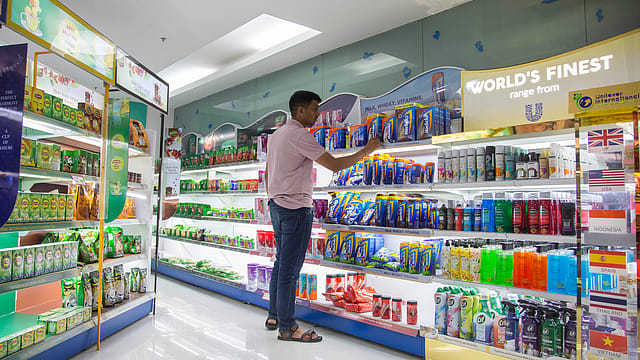HUL versus Reliance: India's FMCG universe promises to be full of action
ADVERTISEMENT

At his last quarterly results meeting (Q1FY26) on Thursday, former managing director and CEO of Hindustan Unilever Ltd (HUL), Rohit Jawa, had every reason to smile. No, not because it was his last day in the organisation where he spent 37 years, but because after months of compressed demand, the FMCG major finally reported market share growth across categories. The outgoing MD said that the company had gained 250 basis points of market share. The company had been losing market share, especially to regional brands across markets which were not just offering competitive pricing but had also upped their game in product quality and distribution.
“As we guided last quarter, we expected macro-economic growth around the fiscal and monetary actions taken by the government, strong agricultural produce and better monsoon. Our rural growth that had lagged, is back to growing every quarter and is sustaining. Even urban growth is back, though not as fast as rural. The macro recovery is positive and we hope that this gradual recovery should sustain. The fact that inflation is low makes a big difference to urban consumers,” said Jawa. The ₹62,000 crore FMCG mammoth in Q1FY26 reported a 7.6% growth in profit (in the corresponding quarter of the last fiscal year) and 5% underlying sales growth and a 4% underlying volume growth.
A large part of the FMCG major’s market share growth has come on the back of premiumisation and that would continue to be its strategy going forward. “Our growth is driven by our strategy to move to faster growth spaces, new channels and new segments and also grow competitively. We have grown our market shares this quarter, which means a part of our growth has also come from competitive growth. However, our real focus now is to keep moving our portfolio to faster growth spaces. Therefore, when that segment of our business grows bigger, automatically our natural growth rate will go up. Over the next two years, we see our categories in core, future-core and market-makers,” Jawa explained.
December 2025
The annual Fortune 500 India list, the definitive compendium of corporate performance, is out. This year, the cumulative revenue of the Fortune 500 India companies has breached $2 trillion for the first time. Plus, find out which are the Best B-schools in India.
While core consists of products such as Surf Excel detergent or Dove soap, future-core comprises new-age products such as liquid detergents and fabric softeners while market-makers would include products such as hair serums, protein bars and energy drinks as well as its portfolio of D2C brands such as Minimalist, Wellbeing Nutrition and OZiva.
“We have seen a 500 basis points shift to future-core in the last two years. The acquisition of Minimalist, OZiva and our market-makers portfolio of D2C are growing quite fast and that’s making a difference to our topline. So, that’s really a combination of portfolio actions, better growth in our core and macro conditions that is leading to the growth trend that you see at this moment,” Jawa said.
In fact, executive director, finance and IT & CFO, Ritesh Tiwari, claimed that premiumisation is a secular trend and rural India is also lapping up premium products. “Premium is not just for urban; it is for rural as well. People buy Dove soap in rural markets too. They may buy smaller packs but they buy.” In fact, regional brands are premiumising too. If you travel to the interiors of Bihar or Uttar Pradesh, detergent brands such as Ghadi or Fena are aggressively pushing their washing machine variants. One of the highest-selling SKUs of local masala brands in these markets is oregano and chilli flakes.
The Reliance Phenomena
Regional brands are posing stiff competition to FMCG giants such as HUL. Unlike earlier, they are not fly-by-night operators. They are here to stay for the long haul. However, HUL may have a bigger upstart to worry about, Reliance Retail . Almost half of HUL’s revenue comes from its core categories, which are mass brands and Reliance’s FMCG strategy is also focused on the masses.
Reliance’s FMCG brands (currently part of Reliance Retail, but to be demerged into an independent FMCG company soon) are already available in close to one million stores and the plan is to be in 10 million by 2030. “So far Reliance might not have impacted the big guys but the day isn’t far away when they will. They are focusing on volume growth and most of the FMCG companies are struggling with volume growth,” points out Sriprakash Nadadhur Sridharan, founder, Prajna Consulting.
While HUL is talking about focusing on future-core and market-makers and has acquired D2C companies such as Minimalist, Oziva and Nutrition Well-Being to fuel its premiumisation strategy, Reliance has been actively acquiring mass legacy brands such as Velvette, SIL and Campa Cola. “Reliance has been picking up nostalgic brands and giving them a new lease of life. Velvette is a personal care brand, it will be interesting to see how they turn it around,” says Sridharan.
Reliance has also been winning over the trade with almost 10% higher margins. The upstart has already started deploying its telecom tactic of price wars in the FMCG industry - After acquiring Campa Cola, it launched 200 ml of Campa Cola at a ₹10 price-point, thereby forcing incumbents, Pepsi and Coke to slash prices.
